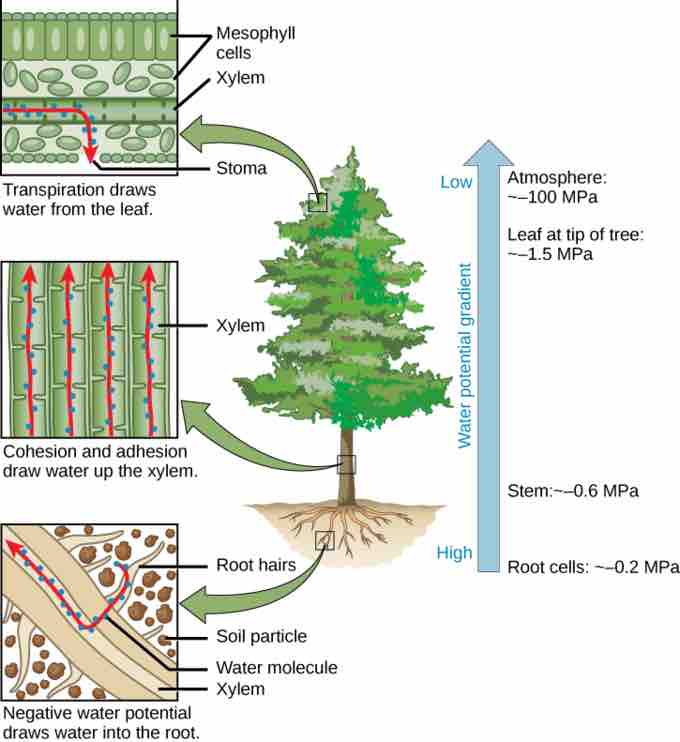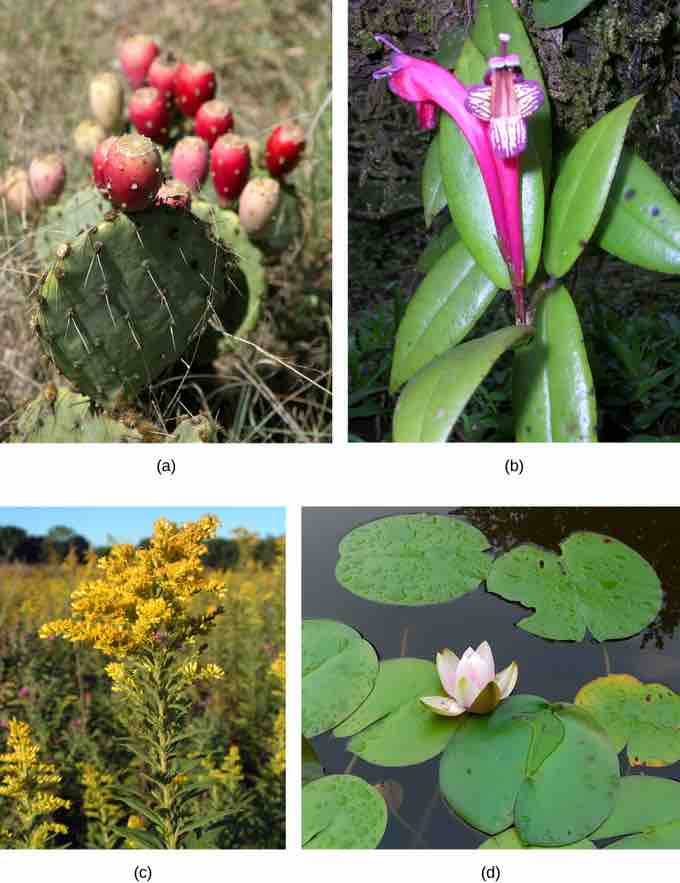Movement of Water and Minerals in the Xylem
Most plants obtain the water and minerals they need through their roots. The path taken is: soil -> roots -> stems -> leaves. The minerals (e.g., K+, Ca2+) travel dissolved in the water (often accompanied by various organic molecules supplied by root cells). Water and minerals enter the root by separate paths which eventually converge in the stele, or central vascular bundle in roots.
Transpiration is the loss of water from the plant through evaporation at the leaf surface. It is the main driver of water movement in the xylem. Transpiration is caused by the evaporation of water at the leaf, or atmosphere interface; it creates negative pressure (tension) equivalent to –2 MPa at the leaf surface. However, this value varies greatly depending on the vapor pressure deficit, which can be insignificant at high relative humidity (RH) and substantial at low RH. Water from the roots is pulled up by this tension. At night, when stomata close and transpiration stops, the water is held in the stem and leaf by the cohesion of water molecules to each other as well as the adhesion of water to the cell walls of the xylem vessels and tracheids. This is called the cohesion–tension theory of sap ascent.
The cohesion-tension theory explains how water moves up through the xylem. Inside the leaf at the cellular level, water on the surface of mesophyll cells saturates the cellulose microfibrils of the primary cell wall. The leaf contains many large intercellular air spaces for the exchange of oxygen for carbon dioxide, which is required for photosynthesis. The wet cell wall is exposed to the internal air space and the water on the surface of the cells evaporates into the air spaces. This decreases the thin film on the surface of the mesophyll cells. The decrease creates a greater tension on the water in the mesophyll cells, thereby increasing the pull on the water in the xylem vessels. The xylem vessels and tracheids are structurally adapted to cope with large changes in pressure. Small perforations between vessel elements reduce the number and size of gas bubbles that form via a process called cavitation. The formation of gas bubbles in the xylem is detrimental since it interrupts the continuous stream of water from the base to the top of the plant, causing a break (embolism) in the flow of xylem sap. The taller the tree, the greater the tension forces needed to pull water in a continuous column, increasing the number of cavitation events. In larger trees, the resulting embolisms can plug xylem vessels, making them non-functional.

Cohesion–Tension Theory of Sap Ascent
The cohesion–tension theory of sap ascent is shown. Evaporation from the mesophyll cells produces a negative water potential gradient that causes water to move upwards from the roots through the xylem.
Control of Transpiration
Transpiration is a passive process: metabolic energy in the form of ATP is not required for water movement. The energy driving transpiration is the difference in energy between the water in the soil and the water in the atmosphere. However, transpiration is tightly controlled. The atmosphere to which the leaf is exposed drives transpiration, but it also causes massive water loss from the plant. Up to 90 percent of the water taken up by roots may be lost through transpiration.
Leaves are covered by a waxy cuticle on the outer surface that prevents the loss of water. Regulation of transpiration, therefore, is achieved primarily through the opening and closing of stomata on the leaf surface. Stomata are surrounded by two specialized cells called guard cells, which open and close in response to environmental cues such as light intensity and quality, leaf water status, and carbon dioxide concentrations. Stomata must open to allow air containing carbon dioxide and oxygen to diffuse into the leaf for photosynthesis and respiration. When stomata are open, however, water vapor is lost to the external environment, increasing the rate of transpiration. Therefore, plants must maintain a balance between efficient photosynthesis and water loss.
Plants have evolved over time to adapt to their local environment and reduce transpiration. Desert plant (xerophytes) and plants that grow on other plants (epiphytes) have limited access to water. Such plants usually have a much thicker waxy cuticle than those growing in more moderate, well-watered environments (mesophytes). Aquatic plants (hydrophytes) also have their own set of anatomical and morphological leaf adaptations.

Reducing Transpiration
Plants are suited to their local environment. (a) Xerophytes, like this prickly pear cactus (Opuntia sp.) and (b) epiphytes such as this tropical Aeschynanthus perrottetii have adapted to very limited water resources. The leaves of a prickly pear are modified into spines, which lowers the surface-to-volume ratio and reduces water loss. Photosynthesis takes place in the stem, which also stores water. (b) A. perrottetii leaves have a waxy cuticle that prevents water loss. (c) Goldenrod (Solidago sp.) is a mesophyte, well suited for moderate environments. (d) Hydrophytes, like this fragrant water lily (Nymphaea odorata), are adapted to thrive in aquatic environments.
Xerophytes and epiphytes often have a thick covering of trichomes or stomata that are sunken below the leaf's surface. Trichomes are specialized hair-like epidermal cells that secrete oils and other substances. These adaptations impede air flow across the stomatal pore and reduce transpiration. Multiple epidermal layers are also commonly found in these types of plants.